A few years ago, I was digging through some of my parent’s old stuff, dedicated to cleaning up the mess in the garage and using it for something other than a bunch of forgotten trash.
Imagine my surprise when I found a ton of old paper money in a box! As an enthusiast for old money in general, I was very excited to further inspect my newly-found small treasure.
One of the many bills and coins that were there was a stack of $2 bills from 1953. Spoiler alert, I didn’t get rich, but I did find out everything there is to know about this bill, so continue reading to learn more about the 1953 $2 bill value, history, and fun facts.
1953 $2 Bill Value Details
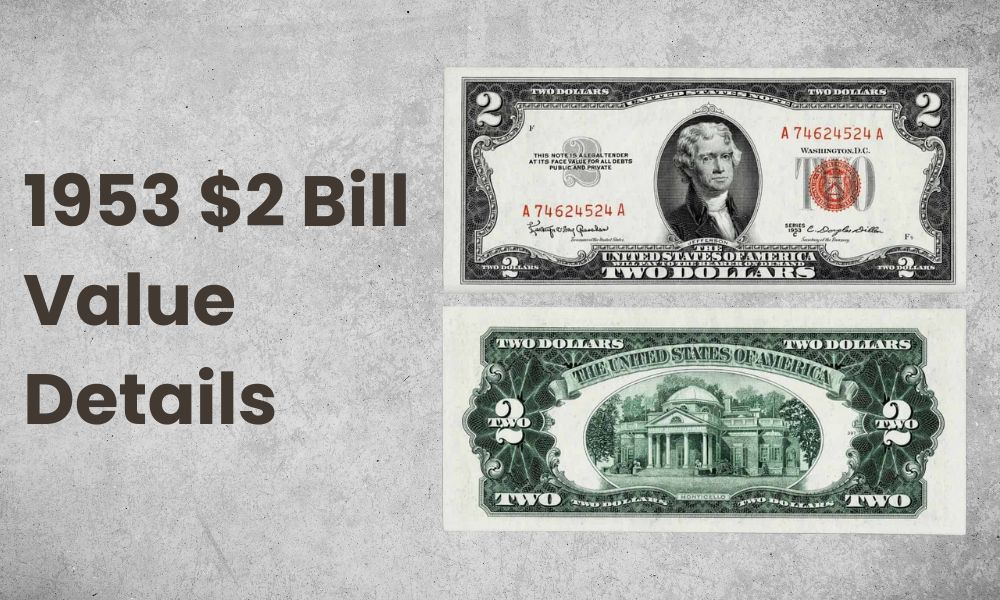
- Category – $2 bill
- Producer – Bureau of Engraving and Printing
- Print volume – around 80 million
- Obverse designer – Clair A. Huston and Alvin R. Meissner
- Reverse designer – Clair A. Huston and Alvin R. Meissner
- Composition – cotton and linen
- Dimensions – 18.85 centimeters (7.4 inches) x 7.94 centimeters (3.1 inches)
A $2 bill printed in 1953 is a paper bill produced by the US Bureau of Engraving and Printing (BEP). BEP printed around 80 million of these bills in 1953, which is why this bill is not particularly rare or difficult to find.
In fact, if you have a 1953 $2 bill, you can use it to buy things! It is still in circulation, although not a lot of people know this, so you may have some problems if a merchant is not familiar with this fact.
This paper bill is made of a blend of cotton and linen, possibly along with some other materials in a smaller percentage, to prevent forfeiting.
The most interesting part about this 2-dollar note is the red seal.
1953 $2 Bill Value Chart
As many of the $2 bills were printed in the year 1953, which wasn’t that long ago, this bill is not rare, and therefore, not really valuable.
Its value starts at $2 for any condition or serial number because it is still legal to use it. Therefore, if you want to sell it, you can at least get the amount of money equal to its face value.
The better the condition of its bill, the higher its possible value is. If you have a bill in perfect condition, you may be able to get as much as forty times its face value, and possibly even more if your bill has a unique or interesting serial number.
BEP always prints so-called star notes – a series of bills that have a star instead of a letter at the beginning of a serial number. These are used to replace the notes that come out defective or faulty after the printing process.
Star paper bills are generally more valuable than regular ones, so they are slightly more expensive than those with a letter at the beginning of a serial number.
If you have one of these, you can expect to sell it for a hundred dollars, and even more, if the note is interesting in more ways than one.
| Condition | 1953 $2 Bill Value | 1953 $2 Star Bill Value |
| Good | $2 | $2 |
| Very good | $2 | $2 – $3 |
| Fine | $2 | $2 – $4 |
| Very fine | $2 – $3 | $2 – $5 |
| Extremely fine | $2 – $4 | $2 – $6 |
| About uncirculated | $2 – $5 | $2 – $7 |
| Uncirculated | $2 – $10 | $2 – $15 |
| Gem uncirculated | $2 – $20 | $2 – $30 |
| Superb gem uncirculated | $2 – $40 | $2 – $50 |
| 70 gem uncirculated | $2 – $80 + | $2 – $100 + |
1953 $2 Bill Value & Varieties Guide
The 2-dollar notes from 1953 come in five different varieties, depending on the serial number printed on them. There is a plain note, a star note, and A, B, and C notes. Let’s learn more about them individually.
1953 $2 Bill Value
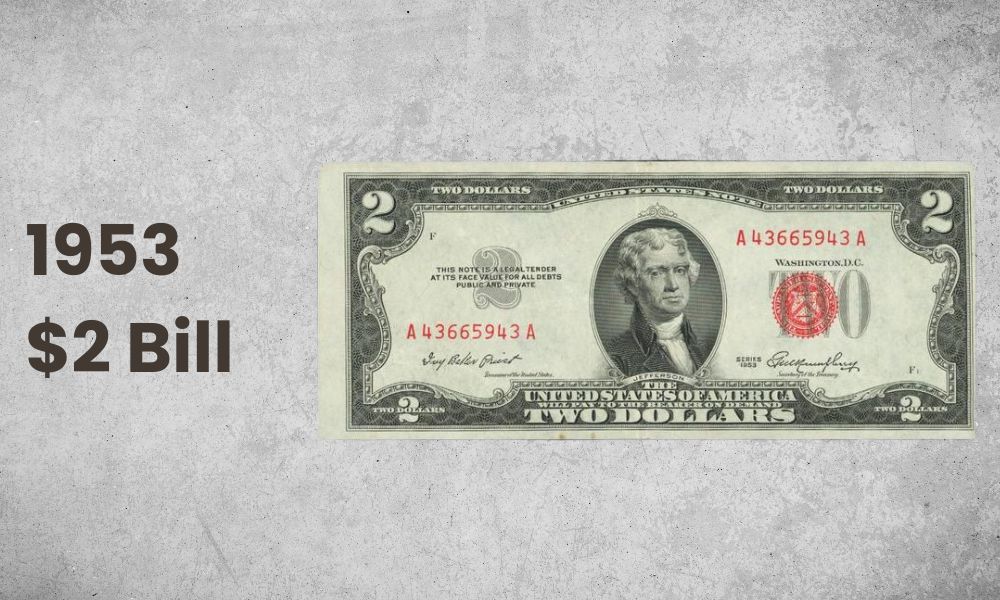
- Type – $2 paper note
- Material – cotton and linen
- Series – first
- Place of printing – Washington D.C.
- Year of printing – 1953
- Face value – $2
- Price – $2 – $80 +
- Quantity printed – approximately 20 million
- Designer – Clair A. Huston and Alvin R. Meissner
- Dimensions – 18.85 centimeters (7.4 inches) x 7.94 centimeters (3.1 inches)
The first series of a two-dollar bill from 1953 was one where no serial number is indicated on the note.
While it’s not clear how many of these notes were printed exactly, we can assume that there were around 20 million of them, just like in almost all the other series.
1953-A $2 Bill Values
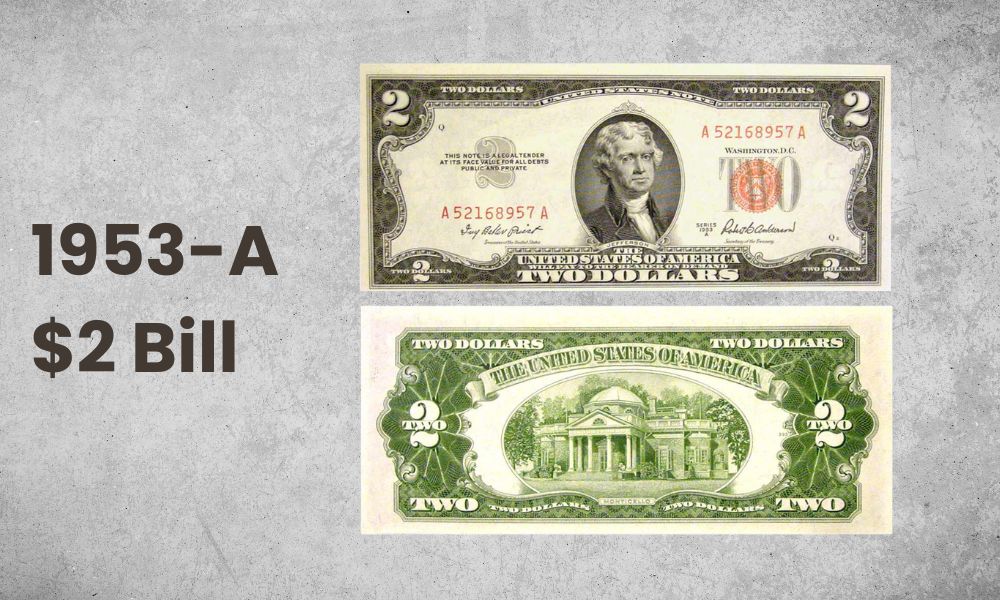
- Type – $2 paper note
- Material – cotton and linen
- Series – A
- Place of printing – Washington D.C.
- Year of printing – 1953
- Face value – $2
- Price – $2 – $80 +
- Quantity printed – approximately 20 million
- Designer – Clair A. Huston and Alvin R. Meissner
- Dimensions – 18.85 centimeters (7.4 inches) x 7.94 centimeters (3.1 inches)
The next series of 2-dollar bills in 1953 was the A series.
1953-B $2 Bill Value
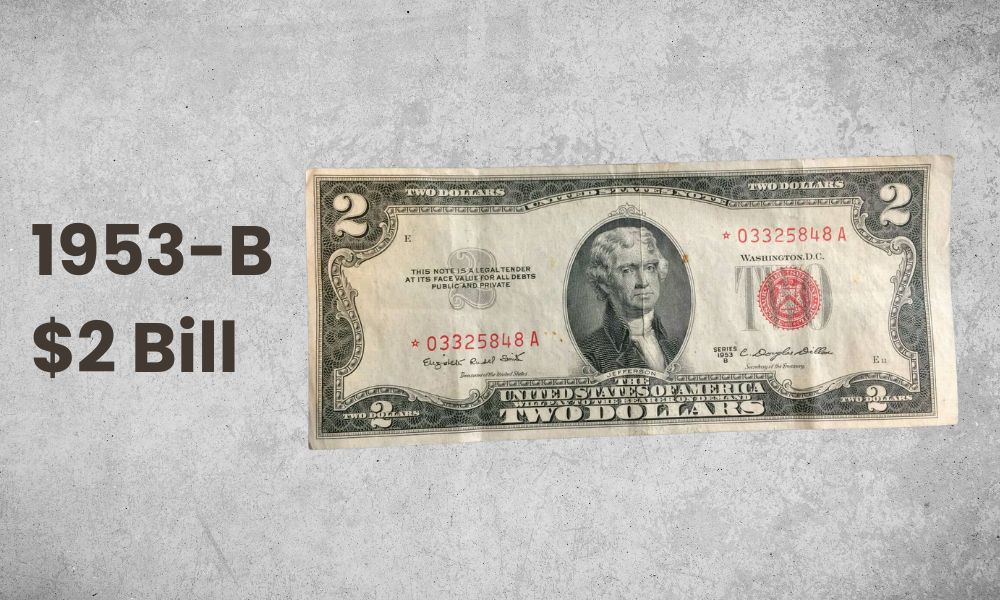
- Type – $2 paper note
- Material – cotton and linen
- Series – B
- Place of printing – Washington D.C.
- Year of printing – 1953
- Face value – $2
- Price – $2 – $80 +
- Quantity printed – approximately 20 million
- Designer – Clair A. Huston and Alvin R. Meissner
- Dimensions – 18.85 centimeters (7.4 inches) x 7.94 centimeters (3.1 inches)
The third type of $2 bill printed in 1953 is series B.
1953-C $2 Bill Value
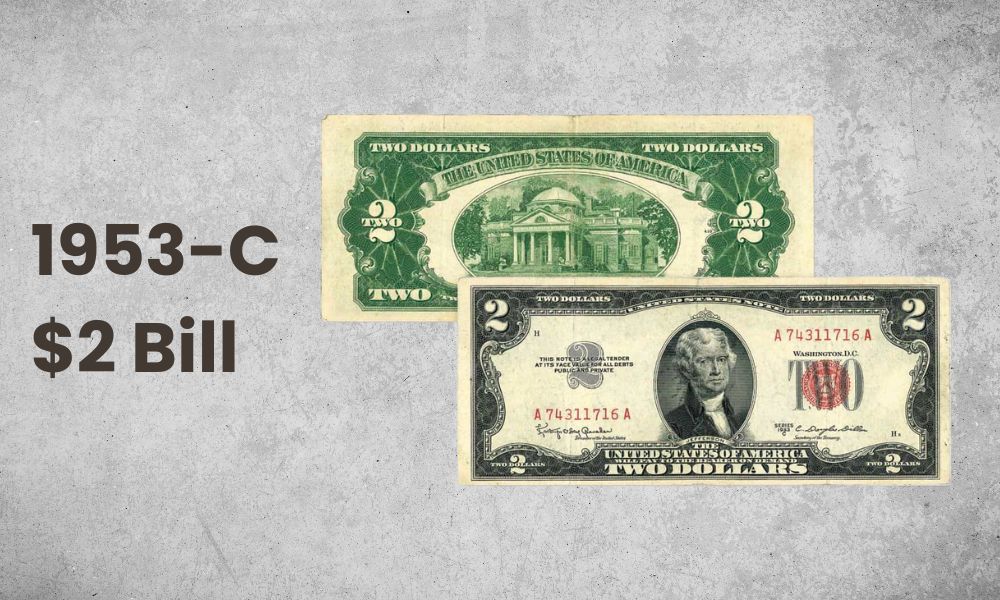
- Type – $2 paper note
- Material – cotton and linen
- Series – C
- Place of printing – Washington D.C.
- Year of printing – 1953
- Face value – $2
- Price – $2 – $80 +
- Quantity printed – approximately 20 million
- Designer – Clair A. Huston and Alvin R. Meissner
- Dimensions – 18.85 centimeters (7.4 inches) x 7.94 centimeters (3.1 inches)
The final series of the $2 bill from 1953 is series C.
1953 $2 Star Bill Value
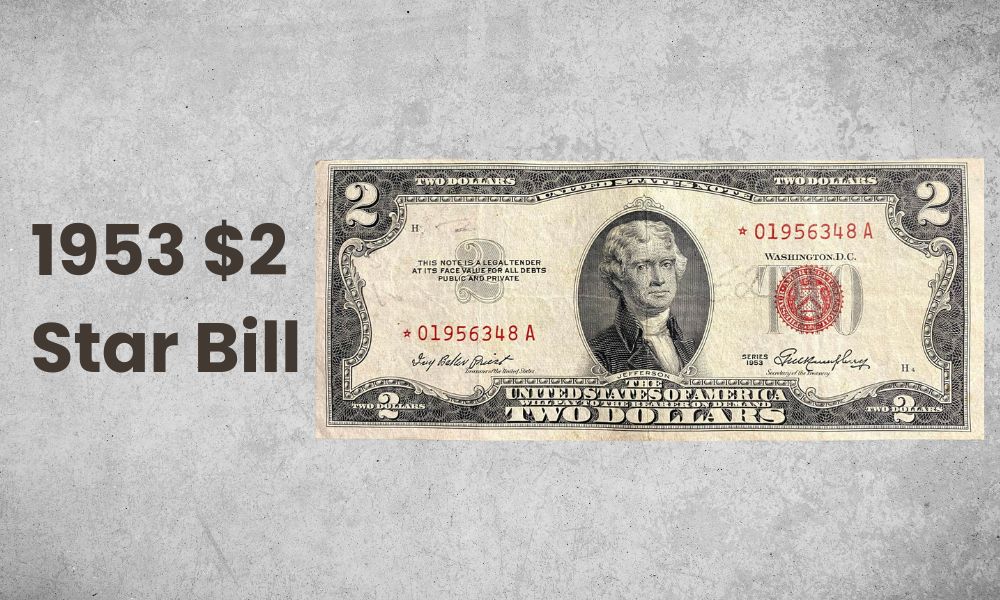
- Type – $2 paper note
- Material – cotton and linen
- Series – *
- Place of printing – Washington D.C.
- Year of printing – 1953
- Face value – $2
- Price – $2 – $80 +
- Quantity printed – N/A
- Designer – Clair A. Huston and Alvin R. Meissner
- Dimensions – 18.85 centimeters (7.4 inches) x 7.94 centimeters (3.1 inches)
Finally, the most valuable and rarest series of 2-dollar notes from 1953 is the one in which the serial number starts with a star instead of a number or a letter.
It’s unclear how many of the star notes were printed for the $2 bill from 1953. We can speculate that it was around a million to five, based on the information we have on how many star notes are printed in general.
Keep in mind that all of the varieties, excluding the star one, are equally (in)valuable. Unless a bill is in a perfect gem state, has a unique serial number, or has any other interesting feature that makes it stand out, it is not worth a lot.
Aside from the series indication, all of the varieties are the same in terms of design, material, dimensions, as well as place of printing.
1953 $2 Bill History
The history of a $2 bill starts in the year 1862. Since then, almost two billion of these notes have been printed. According to the BEP website, the exact number is 1 827 182 128.
You can see why these notes aren’t rare at all. If we tried to distribute all of them to all the people in the world, a quarter of the world’s population would get one!
The two-dollar bill’s design has changed several times since it was first introduced to the US market. The now well-known portrait of Thomas Jefferson on the obverse was first put on a $2 bill in 1928.
Back then, the obverse of a note featured Jefferson’s home, Monticello. In 1976 the design was changed to the portrayal of the Declaration of Independence, the design that stayed actual until the production of a 2-dollar bill was discontinued, in 1963.
Fun fact, the two-dollar bill was never really famous among people. It had a reputation for being used for illegal activities, such as bribing and prostitution.
Nowadays, most people who find this note aren’t aware of the fact that it can still be legally used, so they just hang onto it or get rid of it.
1953 $2 Bill Appearance
Despite not being very popular among US citizens, a two-dollar bill from 1953 is beautiful in its own way.
The reverse of the note features a portrait of Thomas Jefferson, the third American president and the author of the Declaration of Independence. His portrait sits at the center of the bill.
On the portrait’s left side is a number two on which the words THIS NOTE IS A LEGAL TENDER AT ITS FACE VALUE FOR ALL DEBTS PUBLIC AND PRIVATE are written.
Below this statement is a serial number and a signature of the United States treasurer. On the right side, you can see a place in which the money was printed, Washington D.C. Above it is the serial number again, and below is the signature of the US Secretary of Treasury.
To the left side of the signature and on the Jefferson portrait’s right side is the series number.
In the lower two corners of the 2-dollar note, you can see the words 2 DOLLARS over the number 2. In the upper two corners there are two 2s and on the inner side of each are the words TWO DOLLARS.
The reverse side of a 2-dollar bill from 1953 features Jefferson’s home, Monticello, in the center, the place in which the ex-US president eventually died.
Above Monticello are the words THE UNITED STATES OF AMERICA.
In the upper corners of the bill you can see the words TWO DOLLARS and in the lower corners, you can see the word TWO written on each side and TWO DOLLARS twice.
1953 $2 Bill Grading
The grading of a $2 bill produced in 1953 is done the same way as with almost all other paper bills, using a 70-point scale.
The worst grade a paper bill can get is 1, meaning that the note is barely recognizable, has severe damage, and is the least valuable.
The highest grade a 2-dollar bill from 1953 can get is 70, meaning that everything on the note is clearly visible, the note is crispy and shiny, and it looks as if it just exited a bank.
Achieving the highest grade is quite rare since this bill has been in circulation for 70 years, at the time of writing. If you do find such a rare note, you can probably sell it for a lot of money.
1953 $2 Bill List of Errors
There are some errors that can happen during the printing process that can affect the value of 2-dollar bills from 1953. While the errors don’t happen often and the BEP rarely puts these into circulation, you may be lucky and have a couple of the errored notes in your possession.
1. Missing Ink
This error happens when the printers run out of ink during the printing process. In this case, the affected bills will have missing parts of the design, or the picture on the notes will be lighter and sometimes even almost transparent.
2. Smeared Ink
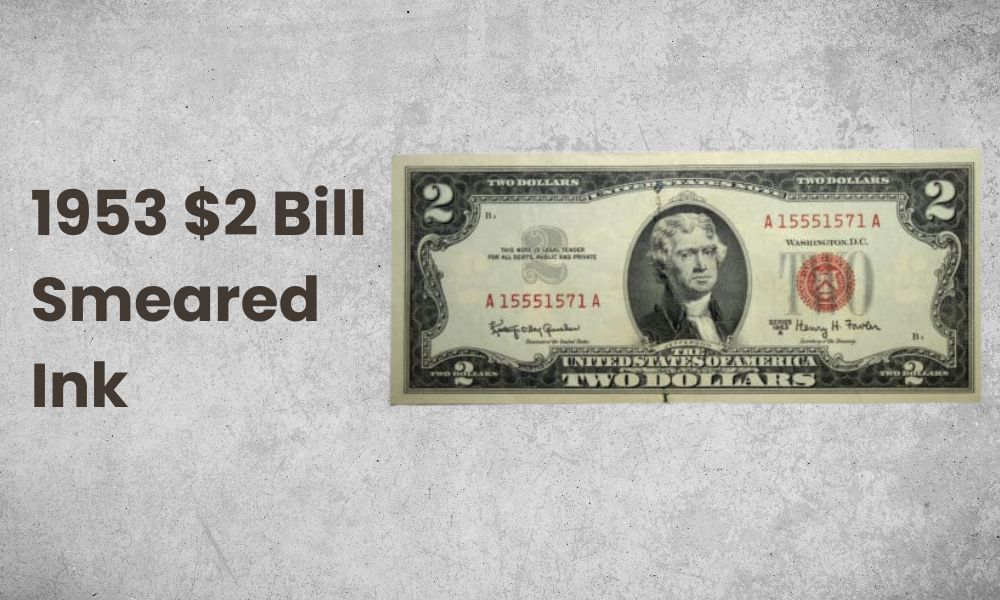
Sometimes the printers malfunction and the factory end up with faulty notes. In the case of smeared ink, as the name says, the ink will be smeared on the note, making the design and words illegible.
3. Mismatched Serial Numbers
A $2 bill from 1953 has a serial number printed on two sides of a reverse of a note. If these are not matching, you may be looking at a highly valuable bill. This means that the factory made a mistake and this error is very interesting to collectors.
4. Unique Serial Numbers
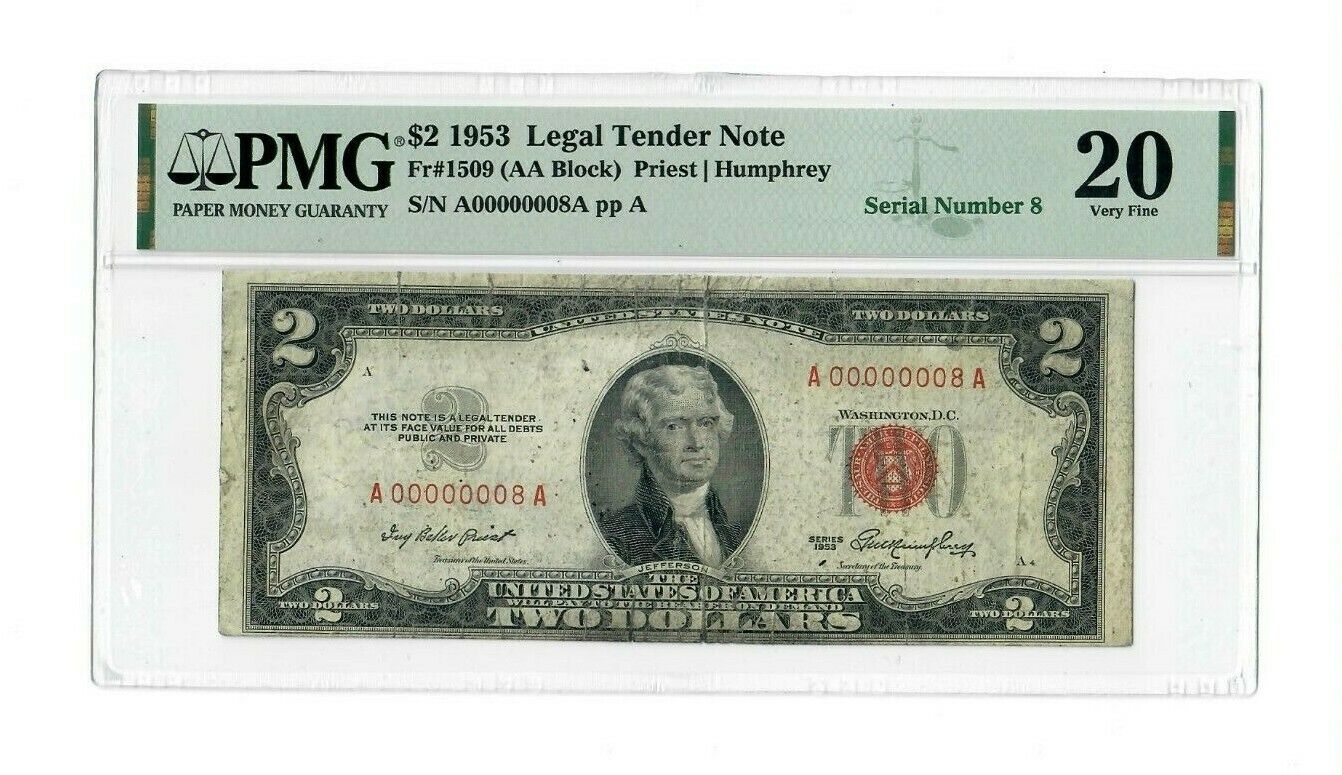
While a unique serial number is not a factory error, it can increase the value of your two-dollar bill from 1953 by a lot.
Look for rare serial numbers, such as those that start with a sequence of the same numbers, represent someone’s birthday, or indicate that the note is one of the first printed.
1953 $2 Bill FAQ
How much is a red seal $2 bill worth?
A two-dollar bill from 1953 is worth at least $2 since it is still legal to use it to purchase stuff. Some rarer versions of this note can be worth up to several hundred dollars, depending on how unique a $2 bill is.
Do they still print $2 bills?
Yes, they do! Although much less frequently than before, $2 bills are still being printed occasionally.
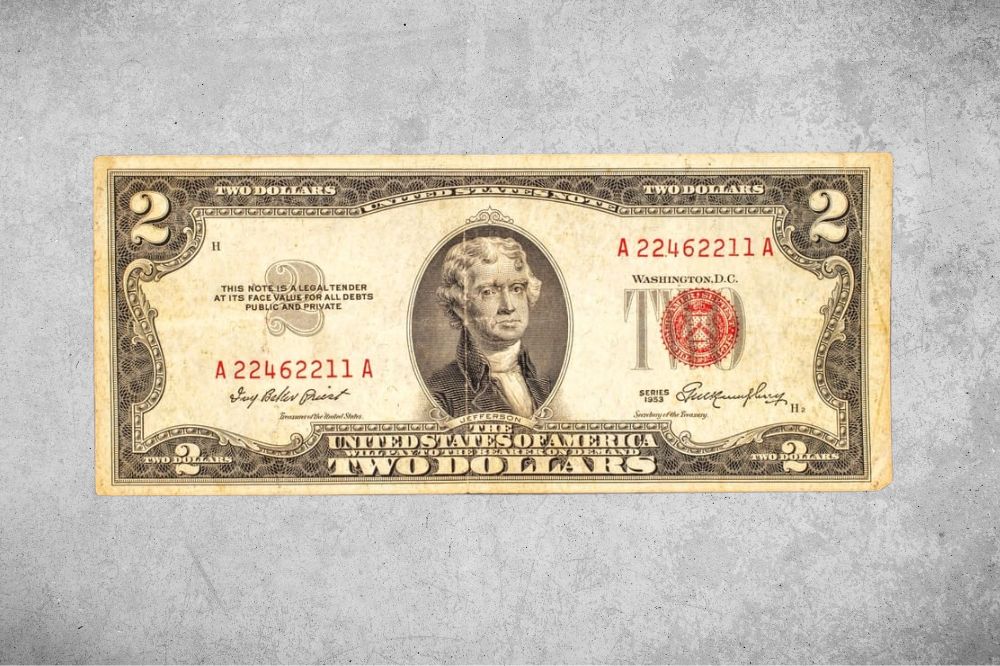
This was very informative and interesting as a friend of mine her husband passed and she found a Jefferson $2 bill 1953.
Thank you for all you do.